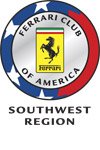
Tech Tip - Curing Fouled Plugs
By: Gary Bobileff
Carburated and older Ferraris tend to suffer from spark plug failure on cold start up. Newer generation injected cars tend to be immune to this failure, because the Bosch injection used on the street cars tends to be very precise in metering extra fuel that is needed for cold start.In addition to hard start up, many multiple carburated motors (i.e. 6 carb) tend to produce fuel wash. This is a condition that occurs every time the trottle is depressed and is especially prevalent in over carburated cars where the squirt of fuel that is injected into each cylinder is of a significant amount. At low engine speeds most of the squirt is consumed, the remainder intermixes with the thin layer of lubricating oil on the cylinder liners, dissolving the oil and washing off the cylinder walls.. This lack of cylinder lubrication leads to premature ring failure (smoking and/or low compression).
Do a simple test if you own a heavily carburated car. Pull the dipstick and smell the oil. If you notice a fuel presence (scent) it's time to change the oil.
Once oil control is lost in the oil control ring excessive oil builds up on top of the piston. When you try to start your motor, this oil will be mixed with incoming fuel and the oil, being heavier than fuel, will coat the spark plug, causing a short to ground. As electricity tries to fire the plug, it may not be able to.
Another culprit is valve guides and seals. As the motor accumulates mileage, these pieces will gain excessive clearance, allowing oil to slip past valves and guides and thus entering the combustion chamber. This mainly occurs when the motor is warm and the oil is thinner and flows easier. When the car sits for a few hours, oil seeps past the worn parts and upon start up - guess what? Same problem - a fouled plug not allowing the motor to run on all its cylinders.
Weak ignition wires, old pitted points, poor or cracked extensions between plugs and wires, cracked or oily distributor caps, weak ignition coils, or faulty carburation can also cause the same problem.
The last thing one wants to do is to drive on less than all cylinders. If not corrected, this can cause serious harm to what was once a great running motor.
But there are two solutions to curing fouled plugs. The first (and hardest) is pulling all the plugs and cleaning or replacing them. But there is an alternative. Obtain a good pair of heavily insulated pliers, preferably ignition pliers made of pressed paper (non-conductive) as sold by Snap-On, Mac, etc.
With the motor running, grab the coil wire with the pliers where it enters the coil and gently remove it. Hold the wire 1/4"-3/4" away from the coil to product an arcing spark. Vary the distance not to exceed 1". At the same time, run the motor to about 2500-3000 RPM. Make sure you don't hold the wire too far away from the coil or the motor will stall or cut out the bank of cylinders you're working on. You will notice that when the spark is arcing, the motor sounds great. Slowly insert the wire back into the coil. If rough running persists, repeat the above procedure, it may take up to a minute. The job is completed when you notice no difference between an arcing coil wire versus an installed wire in the coil. If necessary, repeat on the opposite cylinder bank.
Remember, you are playing with very high voltage (possibly exceeding 40,000 volts). Use extreme caution.
Why does this procedure work? As you pull the coil wire away from the coil, an arc through the air occurs. Electricity is taking the path of least resistance. As the spark gap increases, resistance increases, in turn the plugs will receive a hotter spark (more voltage) which will burn off any contamination on the plug's electrode.
Of course, the above procedure is designed to allow you to enjoy driving on all cylinders. after cold start, which is the most demanding of your ignition system. Howev
For a complete look at Sempre Ferrari, you may want to check out the rest of the articles from Volume 1, Issue 1 - June 1994
